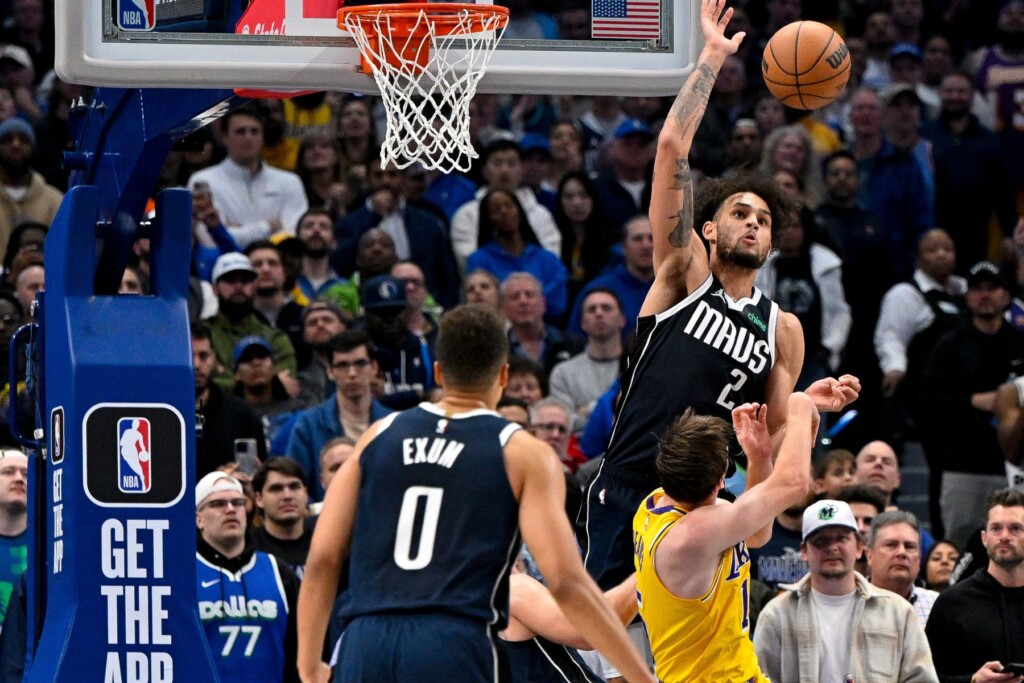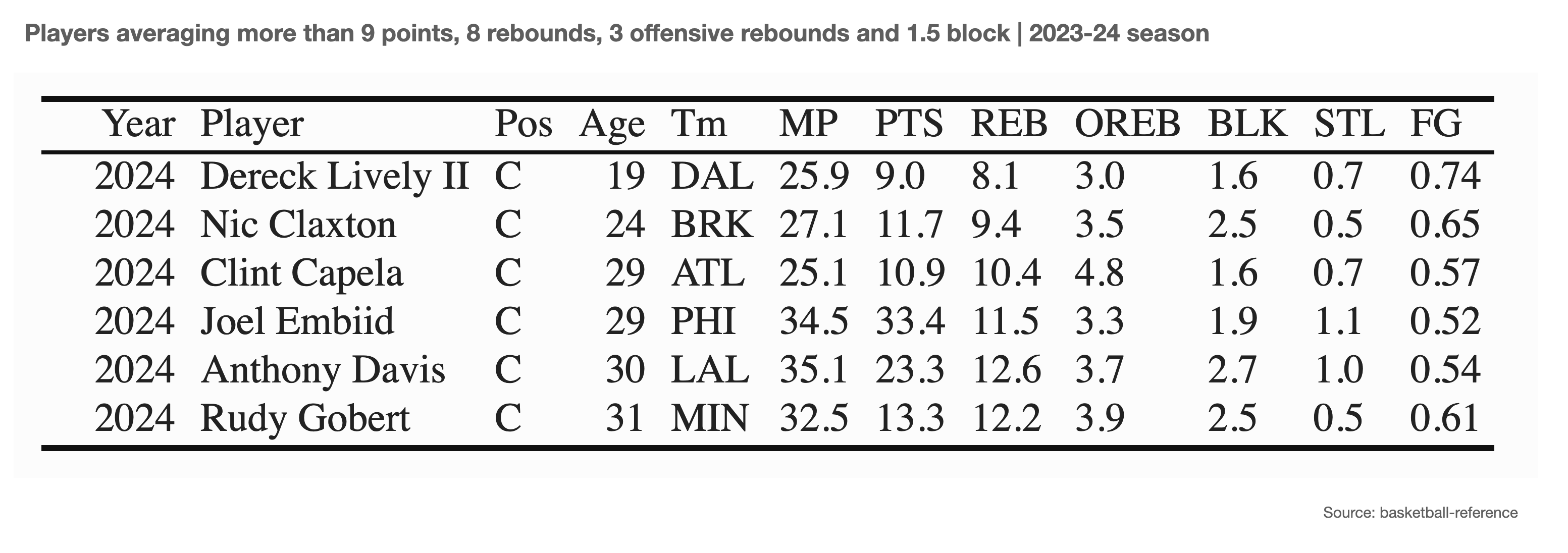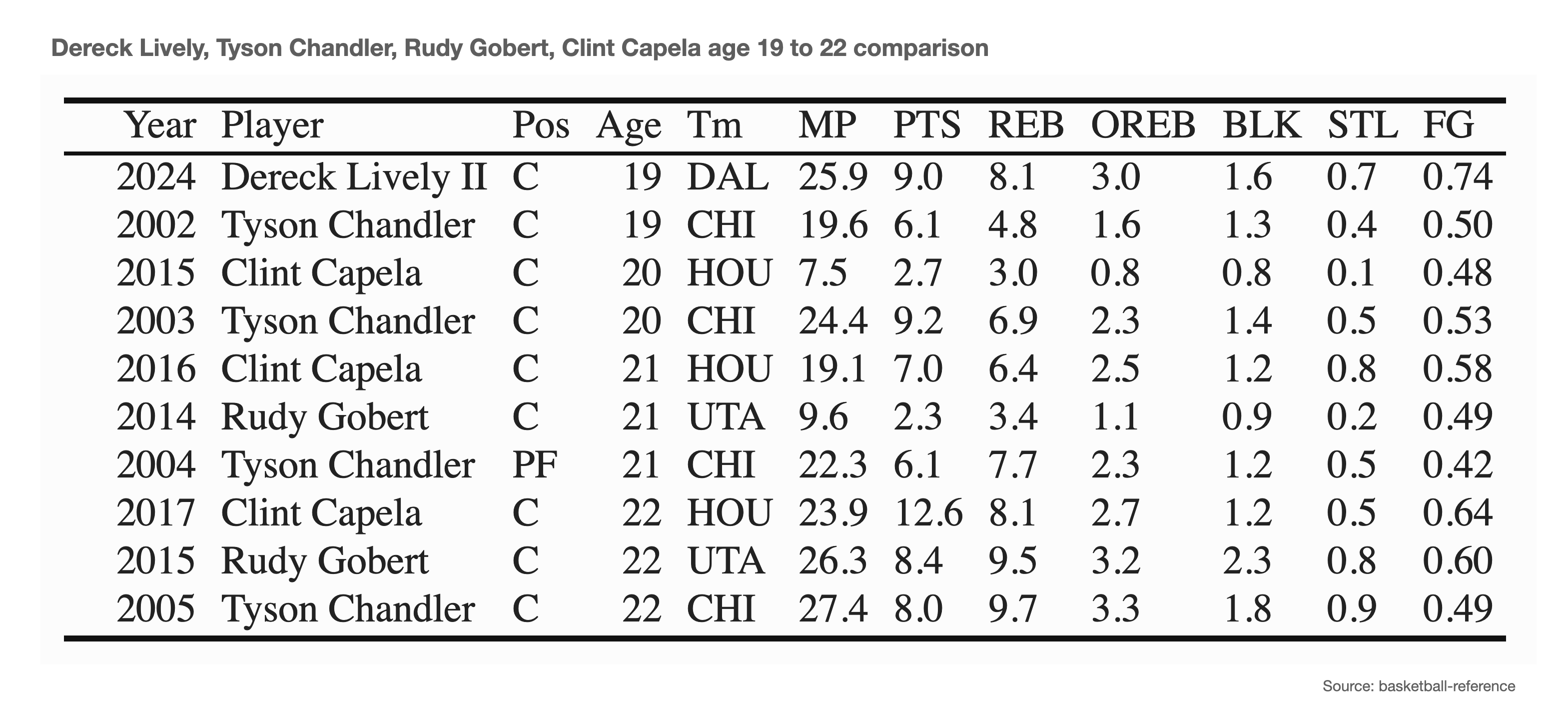I was wrong.
When the Mavericks secured the 10th pick in the June draft, my first reaction was they needed to trade it, seeing it as the crown jewel for a team bereft of assets and in full win-now mode following the trade for Kyrie Irving and with Luka Doncic entering his prime. Given their history of offseason misses, the Mavericks couldn’t afford another gamble: historical data shows there was 10 to 15 percent chance to get an All-Star and 20 to 30 percent to get a starter when drafting in that range. And even if they did hit on one, it typically takes two to three seasons for young players to become full time contributors on good teams.
Defying expectations, the Mavericks took their chances, trading back to the 12th pick with the Oklahoma City Thunder to select intriguing Duke big man Dereck Lively II. Six months later, we can already label this a huge success. They’ve got a starter, possibly a future All-Star, and definitely a crown jewel in their hands.
How did we get here? How did a 19-year-old rookie who averaged merely five points and five rebounds per game in college surpass all expectations and fill the biggest hole in the roster?
Before diving deeper, in my defense, I had suggested that if the Mavericks kept the pick, they should focus on bolstering their defense, length, and athleticism. I pinpointed Cason Wallace ( now excelling defensively with the Oklahoma City Thunder) and Lively as prime candidates. Despite his rawness, Lively was the most captivating prospect when Dallas’ turn came up, his advanced defensive numbers and physical tools too obvious to overlook.
Lively’s performance in the Summer League and training camp led Jason Kidd to test him as a preseason starter. Despite initial struggles, especially against Rudy Gobert in Abu Dhabi, Lively quickly adapted, displaying his most significant trait as a remarkably fast learner. His maturity and preseason performance made me think of Lively as the third most important player in my preseason player projections. Even before playing in his first regular-season game, Lively undoubtedly was going to make an impact in the NBA; it was just a question of when.
Again, I tried to figure out when that time would come by looking at historical data for my predictions. The verdict: 20 to 50 games.
And again, Lively proved me wrong. It took only one game for him to prove he could make an immediate impact, when the 7-foot-1 rookie outperformed his highly regarded French counterpart, Victor Wembanyama, by scoring 16 points and securing 10 rebounds in the Mavericks’ opening night victory over the Spurs.
After another 10 games, it became clear that Lively is easily the best Mavs center of the Doncic era.
Now, not even 25 games into his NBA career, Lively is making us rethink both his short-term impact and long-term potential. Games like his 20-point, 16-rebound, 7-block performance against the Thunder, and the 16-point, 16-rebound outing against the Grizzlies, are signs we might be witnessing something special.
How special? Lively is one of only six players this season who averaging more than 9 points, 8 rebounds, 3 offensive rebounds, and 1.5 blocks. The others are bona fide stars like Gobert, Joel Embiid, and Anthony Davis, or rim-protecting lob threats like Nic Claxton and Clint Capela.
In other words, Lively is already producing like the big man archetypes Dallas has chased for years. Most recently, the Mavericks’ front office tried and failed to trade for Capela in the summer. Instead, they landed a player who is 10 years younger and more athletic.While Lively’s numbers alone might not seem historic, they become significantly more impressive considering his age. According to basketball-reference, only nine other players in the past 25 seasons have produced such statistics before their age-21 season. Just six accomplished this at age 20, and only Dwight Howard matched Lively’s feat at 19. (Yes, these guys did it over full seasons versus a 23-game sample like Lively’s, but again: he’s doing this as a 19-year-old playing his first NBA minutes ever.)
Notice something else interesting about this list? Some of the more intriguing comparisons, including Capela, Lively’s mentor Tyson Chandler, and three-time Defensive Player of the Year Gobert—if we’re aiming high, let’s really aim high—don’t appear. Gobert didn’t generate the kind of stats Lively is putting up until his second NBA season, at age 22. Chandler, on the other hand, reached these milestones in his fourth NBA season, at the same age as Gobert.
Predicting a player’s future in the NBA is challenging. While historical data helps contextualize performance, each player’s development is unique. Some are early bloomers, showing their full potential quickly, while others mature more slowly. Additionally, injuries can alter a player’s trajectory. Perhaps Lively will maximize fast and his ceiling will be peak Capela, something most Mavericks fans would have signed off on before the season. But looking at his numbers—based on the progress we’ve seen we can assume they’ll only improve as the season progresses—his potential seems to be significantly higher. What bolsters my confidence in Lively’s potential is his remarkable desire and speed of learning. In each 10-game segment, he seems to show progress in some part of his game.
Take rim protection, for example.
Just a few weeks ago, I wrote about the Mavericks’ defensive issues, noting that Lively wasn’t on par with elite rim protectors like Gobert, Jaren Jackson Jr., and Brook Lopez. At the time, opponents were making 68 percent of their shots at the rim with Lively as the closest defender, a surprisingly high number. This led me to believe he was still adjusting to the speed of NBA games. In seven games since, Lively has averaged 2.7 blocks per game, recording at least two blocks in all but one of these games. During this stretch, the opponents’ field goal percentage at the rim when Lively defended dropped to 49 percent, positioning him among the league’s elite rim protectors. His foul rate also dropped, enabling him to play more minutes, which has been vital due to the Mavericks’ recent injury issues.
And it’s not just on defense; Lively is making strides at the other end of the court as well. He is shooting at an impressive 74 percent from the field, leading the NBA among the 144 players with enough shot attempts to qualify. Of course, neither Gobert nor Chandler had the good fortune to play with a pick-and-roll maestro like Doncic: of Lively’s 87 made field goals, half have been assisted by Doncic, and all but five of these were scored at the rim.
But the relationship is symbiotic, much like the mutually beneficial bond between a clownfish and an anemone. Just as the clownfish thrives among the anemone’s protective tentacles, Doncic has never had a teammate like Lively, who combines his remarkable length and explosive leaping ability with a ridiculous catch radius, perfectly complementing Doncic’s style of play. Lively’s presence on the court amplifies Doncic’s strengths, covering for him defensively and being an ideal target for his lobs on offense.
The duo of Doncic and Lively has quickly become one of the most efficient high-volume pick-and-roll pairings in the NBA. Per Second Spectrum tracking data, they rank third among all combos with more than 150 picks. This, coupled with Irving’s absence, has led opponents to realize they can’t defend the Doncic-Lively screen actions in the usual manner. Teams have started to blitz Doncic more aggressively—he’s the most doubled ballhandler in the NBA by a significant margin—to force the ball out of his hands. This strategy puts Lively and others in a position to make quick decisions in 4-on-3 situations, challenging them to adapt and respond to the increased pressure.
And like in other areas, Lively has shown progress here as well.
Watching Lively’s Duke and Mavericks game tape, it was evident he was always a quick and smart passer. However, in 4-on-3 situations, particularly when he received the ball at the top of the key on a short roll, he tended to opt for a quick pass, almost to a fault.
When that happened during a recent game against the Thunder, Kidd challenged Lively to be more aggressive and look to finish first. According to Lively, the message was blunt: “Not to pass the f***ing ball.”
What followed were arguably the three most crucial plays of the Mavericks’ young season, even though the game ended in a loss. I’ve clipped them together so you can watch. These three plays not only showcased Lively’s remarkable length and agility but also demonstrated his rapid learning ability. He catches the ball at the top of the key, takes just one dribble, and gets to the rim within a second. If these plays offer a glimpse of what the future holds, the rest of the NBA should be scared.
Another tactic frequently employed against the Doncic and Lively screening combinations is having wing players defend Lively. This allows teams to switch instead of dropping or blitzing in the pick-and-roll. Despite having a limited post game to exploit smaller defenders down low, Lively is making an impact around the basket with his hustle and high motor. One effective strategy to capitalize on the switch or aggressive on-ball coverage against Doncic is to crash the offensive glass. Lively is averaging three offensive rebounds per game in just 26 minutes of play, a feat only DeAndre Jordan has accomplished in Dallas since Doncic was drafted. Furthermore, Lively has already had two games with more than six offensive rebounds; the entire team only accomplished that three times last season.
The increase in switching and the associated rise in offensive rebounding is not a recent trend; it’s an evolutionary shift that I extensively covered last April. Last season ended disastrously in large part because the Mavericks were behind that curve. Now it appears they have turned a corner, with Lively leading the way.
It’s important to remember that Lively is still a raw talent with ample room for improvement. At just 19 years old, he lacks the bulk and experience to shut down mobile scoring bigs, as demonstrated in the Mavericks’ last two matchups, when Jaren Jackson Jr. and Anthony Davis scored 40 and 37 points, respectively. Lively still gets bullied by stronger big men when defending against drives and post-ups, and on the defensive glass. However, he has emerged as the brightest spot on a team that is off to a surprisingly fast start. And given how wrong I’ve been already, I’m done putting limits on how much more growth we could see from him this season.
Author










